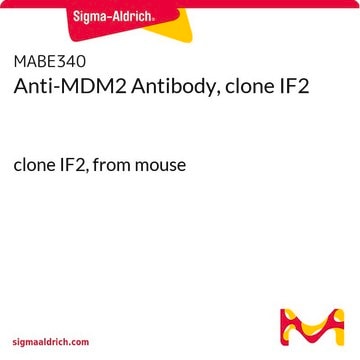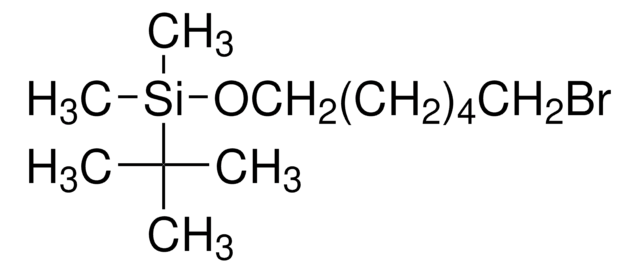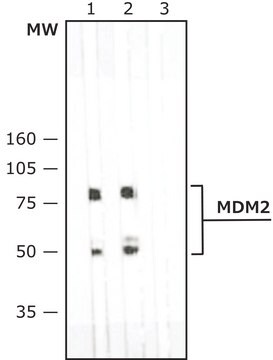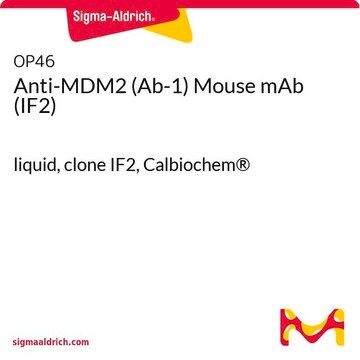おすすめの製品
由来生物
mouse
品質水準
抗体製品の状態
culture supernatant
抗体製品タイプ
primary antibodies
クローン
2A10, monoclonal
化学種の反応性
human
テクニック
immunoprecipitation (IP): suitable
western blot: suitable
アイソタイプ
IgG2aκ
NCBIアクセッション番号
UniProtアクセッション番号
輸送温度
wet ice
ターゲットの翻訳後修飾
unmodified
遺伝子情報
human ... MDM2(4193)
詳細
MDM2 is an E3 ubiquitin ligase that is most widely studied for its role in regulating the p53 tumor suppressor. MDM2 antagonizes the transcriptional activity of p53 in two main ways. The N-terminal of MDM2 interacts and disables the transactivation domain of p53. In addition, the C-terminal E3 ligase region of MDM2 can attach monoubiquitin to p53 resulting in the transport of p53 from the nucleus to the cytoplasm, thereby preventing the interaction of p53 with target DNA sequences. In addition, MDM2 may also attach polyubiquitin chains to p53, resulting in the degradation of p53 by the proteosome. MDM2 may produce these effects in cooperation with the Mdmx protein. Overall, MDM2 inhibits the ability of p53 to induce cell cycle arrest or apoptosis, and may contribute to oncogenesis.
アプリケーション
Anti-MDM2 Antibody, clone 2A10 is a Mouse Monoclonal Antibody for detection of MDM2 also known as E3 ubiquitin-protein ligase Mdm2 or Hdm2 & has been validated in WB & IP.
Immunoprecipitation Analysis: A representative lot was used by an independent laboratory in human lymphoblastoid cell line (NL553) treated with NCS. (Khosravi, R., et al. (1999). PNAS. 96(26):14973–14977.)
品質
Evaluated by Western Blot in A-549 cell lysate.
Western Blot Analysis: 0.5 µg/mL of this antibody detected MDM2 on 10 µg of A-549 cell lysate.
Western Blot Analysis: 0.5 µg/mL of this antibody detected MDM2 on 10 µg of A-549 cell lysate.
ターゲットの説明
~90 kDa observed. The calculated molecular weight is 55 kDa, however MDM2 has been shown as a ~90 kDa band in western blots (Erhardt, P., et al. (1997). The Journal of Biological Chemistry. 272:15049-15052.). Uniprot describes many isoforms between 12-56 kDa, which can be highly phosphorylated and ubiquitinated.
物理的形状
Format: Purified
Purified mouse monoclonal IgG2aκ cultured supernatant in buffer containing 0.1 M Tris-Glycine (pH 7.4), 150 mM NaCl with 0.05% sodium azide.
アナリシスノート
Control
A-549 cell lysate
A-549 cell lysate
その他情報
Concentration: Please refer to the Certificate of Analysis for the lot-specific concentration.
Not finding the right product?
Try our 製品選択ツール.
保管分類コード
12 - Non Combustible Liquids
WGK
WGK 1
引火点(°F)
Not applicable
引火点(℃)
Not applicable
適用法令
試験研究用途を考慮した関連法令を主に挙げております。化学物質以外については、一部の情報のみ提供しています。 製品を安全かつ合法的に使用することは、使用者の義務です。最新情報により修正される場合があります。WEBの反映には時間を要することがあるため、適宜SDSをご参照ください。
Jan Code
MABE281:
試験成績書(COA)
製品のロット番号・バッチ番号を入力して、試験成績書(COA) を検索できます。ロット番号・バッチ番号は、製品ラベルに「Lot」または「Batch」に続いて記載されています。
Susie Lee et al.
PloS one, 5(6), e10995-e10995 (2010-06-12)
Cell proliferation in all rapidly renewing mammalian tissues follows a circadian rhythm that is often disrupted in advanced-stage tumors. Epidemiologic studies have revealed a clear link between disruption of circadian rhythms and cancer development in humans. Mice lacking the circadian
Jong-Hee Lee et al.
The Journal of biological chemistry, 283(28), 19826-19835 (2008-05-21)
The p53 tumor suppressor protein, a critical modulator of cellular stress responses, is activated through diverse mechanisms that result in its stabilization and transcriptional activation. p53 activity is controlled by transcriptional, translational, and post-translational regulation. The major mechanisms of p53
Oliver Bischof et al.
Molecular cell, 22(6), 783-794 (2006-06-24)
Cellular senescence and apoptosis have evolved to restrain unwarranted proliferation of potentially tumorigenic cells. Here we show that overexpression of the E3 SUMO ligase PIASy in normal human fibroblasts recruits the p53 and Rb tumor suppressor pathways to provoke a
Kyle P Feeley et al.
Cancer research, 77(14), 3823-3833 (2017-06-04)
p53 deletion prevents the embryonic lethality of normal tissues lacking Mdm2, suggesting that cells can survive without Mdm2 if p53 is also absent. Here we report evidence challenging this view, with implications for therapeutically targeting Mdm2. Deletion of Mdm2 in
Shunbin Xiong et al.
Cancer research, 70(18), 7148-7154 (2010-08-26)
High levels of the critical p53 inhibitor Mdm4 is common in tumors that retain a wild-type p53 allele, suggesting that Mdm4 overexpression is an important mechanism for p53 inactivation during tumorigenesis. To test this hypothesis in vivo, we generated transgenic
ライフサイエンス、有機合成、材料科学、クロマトグラフィー、分析など、あらゆる分野の研究に経験のあるメンバーがおります。.
製品に関するお問い合わせはこちら(テクニカルサービス)








